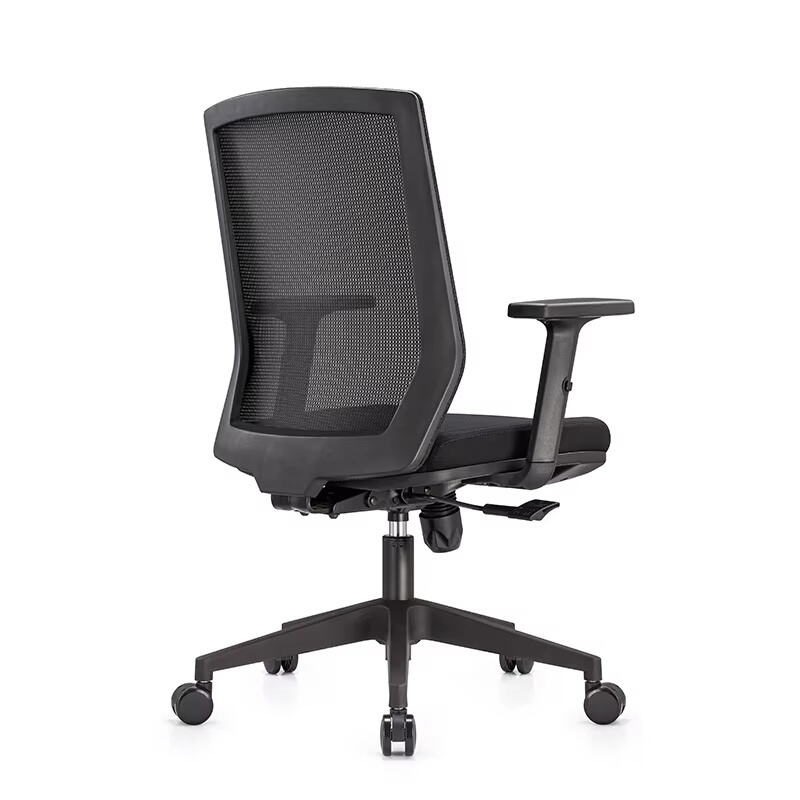
Why Ergonomic Mesh Chairs Are Ideal for Office Comfort
Breathability for All-Day Comfort
Mesh chairs with breathable fabric really boost office comfort because they let air flow much better than regular padded chairs do. The special mesh material actually circulates air around the body, so people don't get as sweaty or uncomfortable when sitting for those long meetings or work sessions. Some research suggests that offices with these kinds of breathable seating options see workers staying focused longer since the environment just feels nicer overall. Most modern mesh designs come with built-in ventilation features that help keep things cool while supporting proper sitting posture all day long. Of course, not everyone finds them comfortable right away, but many office workers swear by their benefits once they get used to the feel.
Lumbar Support and Posture Alignment
Mesh chairs designed for ergonomics come with built-in lumbar support that keeps the spine in its natural position, something that really matters when it comes to avoiding back problems. Studies have shown time and again that sitting properly affects our general well being and cuts down on tiredness after long hours at work, so spending money on a good chair makes sense in the long run. What sets these chairs apart is the adjustable back support feature, letting people tweak things to match their unique body type and how they prefer to sit throughout the day. This customization leads to better comfort levels and helps maintain proper spinal alignment without feeling forced or uncomfortable.
Versatility for Various Desk Setups
Ergonomic mesh chairs offer quite a bit of flexibility, which is why they work so well across different desk arrangements from home offices right through to big corporate spaces. They adjust pretty well to all sorts of desk heights and styles too, whether someone has one of those standing desks or just the regular old desk setup most people still use. Plus their light weight means these chairs don't weigh down on floors or take forever to move around, making them great picks for team areas where workers need to shift positions frequently throughout the day. That kind of flexibility explains why many businesses continue choosing these particular chairs despite all the other options available nowadays.
Essential Features of the Best Ergonomic Mesh Chairs
High-Quality Mesh Material Durability
Good quality mesh fabric is what really sets apart office chairs that stand the test of time. Mesh just holds up much better against everyday use compared to those regular fabric options we see everywhere else. Some manufacturers actually put their mesh chairs through rigorous testing and offer warranties for around 10 years in normal office environments. The top rated ergonomic models often feature specially designed breathable mesh that doesn't sag over time, which means workers get proper back support day after day. What's great about this kind of durability is that it saves money in the long run while still providing that essential lumbar support people need to stay comfortable during those marathon work sessions.
Adjustable Armrests and Seat Height
Adjustable armrests along with seat height options make all the difference when it comes to getting comfortable at workstations. People come in all shapes and sizes after all, so being able to tweak things according to body type really helps everyone find that sweet spot where they sit properly without slouching or hunching over. Armrests that move around let folks take pressure off their shoulders and neck area which makes a world of difference during long hours at the desk. Seat height adjustment matters just as much because not everyone works at the same kind of desk or has identical leg lengths. Some might need to raise their chair while others prefer it lower depending on what feels right for them personally. Getting this basic setup right goes a long way toward preventing back pain and other issues down the road.
Weight Capacity and Stability
When looking at ergonomic office chairs, weight capacity and how stable they sit matters a lot for keeping people comfortable and safe. The maximum weight a chair can hold isn't just some number on paper it actually determines if the chair will work for everyone in the office space. Chairs that have wider bases tend to be much safer since they don't tip over as easily, which gives workers peace of mind even after sitting through those marathon meetings. Anyone shopping should definitely check out what others say about stability issues online before making a purchase. Real world experiences often tell us more than specs alone about whether a particular chair meets basic needs for both comfort levels and accident prevention.
Adjusting Your Mesh Chair for Maximum Ergonomic Support
Setting the Correct Seat Height
Getting the seat height right on that mesh chair makes all the difference when it comes to sitting ergonomically and keeping legs comfortable. When feet rest flat on the floor, people tend to feel less leg pain and their blood flows better too something that matters a lot after spending hours at work. Most experts suggest setting up chairs so knees end up about even with or just a bit lower than hips. This simple adjustment helps maintain good posture while putting less pressure on the lower back area over time.
Customizing Lumbar Support
Getting the right amount of lumbar support in a mesh chair makes all the difference when it comes to keeping the spine aligned properly and reducing back pain. When the chair actually fits the curve of someone's lower back, they tend to experience way less strain throughout the day. People find that chairs with adjustable lumbar support allow them to sit more naturally without slouching forward or arching their backs unnaturally. Health professionals often talk about how important proper seating posture is for preventing long term issues in the lower back area, something many office workers deal with daily.
Optimizing Tilt and Recline Functions
Knowing how to adjust the tilt and recline features on office chairs helps achieve better ergonomics by redistributing body weight away from pressure points. When someone finds their ideal seat angle, it makes all the difference in staying comfortable throughout those marathon workdays without getting exhausted so quickly. Studies from the American Journal of Industrial Medicine show that people who regularly use the recline function experience better blood flow and less lower back discomfort over time. For anyone spending most of their day seated at a desk, these adjustments aren't just nice to have they're actually pretty important for maintaining good posture and avoiding chronic pain issues down the road.
Maintaining Your Ergonomic Mesh Office Chair
Cleaning and Care Tips for Mesh Fabric
Keeping a mesh office chair well maintained helps maintain a clean work area and cuts down on allergens while making the chair last longer. If someone cleans their mesh regularly, it really does extend how long the fabric stays good looking and functional. The mesh doesn't tear as easily when properly cared for. Want to know how to get rid of those stubborn coffee stains and sweat marks? Let's look at some practical ways to keep that ergonomic mesh chair looking fresh and comfortable for years to come.
- Use a mild soap and water solution to gently clean the fabric, avoiding harsh chemicals that might weaken the material.
- Employ a vacuum with a brush attachment to remove dust and debris, which helps prevent buildup and keeps the chair looking new.
- Avoid excessive moisture during cleaning to maintain the structural integrity of the mesh material.
By following these simple steps, you can ensure your chair remains in optimal condition, providing ergonomic support consistently.
Checking and Tightening Adjustable Components
Routine checks on your office chair's adjustable components are crucial for maintaining its ergonomic integrity and ensuring long-term support. Regularly inspecting and tightening these parts can prevent premature wear and enhance the chairâs performance. Consider the following steps:
- Inspect the screws and connections and tighten them as needed to prevent instability.
- Schedule maintenance checks every three months, as recommended by experts, to ensure the chair's safety and optimal function.
- Be attentive to any signs of looseness or wear in the armrests, seat adjustment levers, or back support mechanisms.
Consistent maintenance not only extends the life of your chair but also maximizes comfort and safety during long periods of use.
When to Consider Chair Replacement
Recognizing the signs of wear and tear in your ergonomic office chair is essential for deciding when a replacement is necessary. Common indicators include noticeable sagging, odd noises, or a decline in comfort. Here are some key points to consider:
- Be vigilant for signs such as a drooping seat or creaky adjustments, which often signal the end of a chair's functional lifespan.
- Follow manufacturer guidelines on durability to maintain optimal health and ergonomic posture, since outdated furniture can lead to discomfort or injury.
- Investing in a new chair when necessary can enhance productivity by ensuring adequate support and comfort for the user.
Replacing a worn-out chair is not just about aesthetics but also about health, as a well-functioning ergonomic chair promotes better posture and efficiency.











